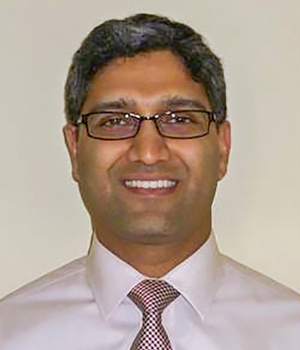 Anand Joshi, MD, MBA
Anand Joshi, MD, MBA
Vice President, Procurement & Strategic Sourcing
NewYork-Presbyterian Hospital
New York, New York
About Anand Joshi:
Born in Queens, New York, Anand Joshi received his undergraduate degree in biochemistry from Harvard University, a master’s in business administration from Columbia Business School, and his M.D. from Columbia University College of Physicians and Surgeons. He was one of the founding members of NewYork-Presbyterian’s Emerging Leadership Council.
“I had my heart set on becoming a physician as early as high school and I had been pre-med throughout my undergraduate years. Even in medical school I had every intention of becoming a practicing physician (pediatric sub-specialist). However, after doing a summer internship at McKinsey & Company after my first year in business school, one thing led to another and I never ended up going to residency. Instead, I joined McKinsey & Company full time as an associate.
“I had the opportunity to lead a project at NewYork-Presbyterian in 2003 which happened to be focused on lowering non-labor expense. That was my first exposure to hospital supply chains, and I have been doing work in this realm ever since.”
In his role as vice president of procurement and strategic sourcing, Joshi is responsible for strategic sourcing, supply chain logistics, and purchase order management. His team of almost 400 people is responsible for the overall management of the $2.2B+ of non-labor expense across the NewYork-Presbyterian Enterprise.
About NewYork-Presbyterian:
NYP comprises four major divisions: NewYork-Presbyterian Hospital (seven campuses in New York City); NewYork-Presbyterian Regional Hospital Network (three campuses in the New York metropolitan region); NewYork-Presbyterian Physician Services; and NewYork-Presbyterian Community and Population Health.
Most rewarding/challenging project in the past 12-18 months:
“The opening of our David H. Koch Ambulatory Care Center. It was the first time my supply chain leadership was able to design a lean, end-to-end supply chain within a new center, and we were able to show how that design should be the model for all our sites. In this center, our team was responsible for supplies all the way from the dock to the bedside and into the procedural areas. As a result of the success of that model – both in terms of efficiency and service levels – now, in our other major campuses, we are being asked to take on more and more of the procedural area and unit-based supply chains.”
Looking forward to:
“I am the executive sponsor for our HERCULES Non-Labor Expense (NLE) Reduction efforts. We have more than 20 cross-campus teams across every major operational area of the hospital – led by specific vice presidents and facilitated by my sourcing team leaders – that are focused on driving down non-labor expense within their scope of operations. As we’ve grown as an Enterprise – from five campuses to 11 – those forums are becoming more and more important for bringing together peer leaders of specific areas (i.e., labs, ORs, cath labs, etc.) on a regular basis.”
How are you better at practicing your profession today than you were 5-10 years ago?
“Early in my career I had found that too often, physicians’ and supply chain executives’ stereotypical views of each other were getting in the way of effective collaboration in driving down supply costs. As a result, over the past 10-15 years I have stressed throughout our sourcing and supply chain organizations that our team focus on engaging physicians closely in our work and building trust-based working relationships with them. The physician leadership at NYP over the years … have consistently supported my team’s efforts to engage physicians directly and be viewed as equal partners in our work with them.”
What are the challenges or opportunities facing the next generation of supply chain executives?
“The next generation of supply chain professionals will face many of the same challenges that we are facing today — but quite likely on a greater scale, and at a faster pace. Successfully meeting those challenges depends almost exclusively on continuing to identify, recruit and retain the most talented professionals possible to address whatever situation arises. I have been fortunate over my years at NYP to experience firsthand what top talent in an organization is able to accomplish. Lots of the details of what we are trying to achieve may shift over time, but surrounding myself with phenomenally talented teams has allowed our organization to navigate whatever’s been thrown at us, and I expect would do so in the future.”
